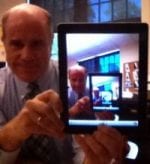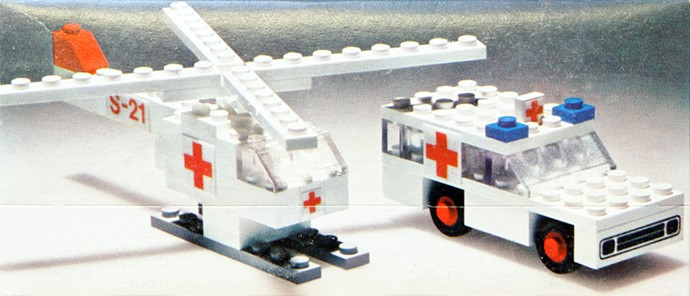My childhood indoor playtime was consumed by construction toys — Lincoln Logs, Wood Blocks,Tinker Toys, an Erector set, and my favorite: the large collection of LEGO pieces that we kept in an old Charles Chips canister. My brother, sister, and I would dump the interlocking rectangular prisms on the family room carpet and proceed to create LEGO structures and vehicles, sometimes bringing in the wood blocks, Lincoln Logs, and our Matchbox cars to create an entire city.
LEGO sets with instructions were not yet widely available in the early seventies. I remember when I first saw the LEGO mini sets on the shelves of Eisenstadt’s Hardware Store and my first purchase: the Rescue Set, with instructions to build a helicopter and ambulance. The set probably had only 15 pieces in all for each item, but for once they were not all right angle bricks, and the set included a spinning rotor!
http://fr.bricker.info/sets/653/
In the ensuing years, LEGO fully developed its instruction based kits, introducing the architecture series and themed sets drawn from pop culture franchises like Star Wars and Marvel Comics. Each new each kit delivered new oddly shaped and dynamic bricks. This combination of creative exploration and exciting, challenging construction kits cemented my lifelong relationship with the LEGO building toy.
LEGO now markets itself not just as a construction activity, but as a STEM education product, including its sophisticated Mindstorms robotics line. These packages challenge students to follow instructions to complete a sophisticated construction project, and in doing so, create a greater opportunity for fact-based, guided learning. Is this more educationally beneficial to students than simply allowing them to play and create with a pile of bricks?
This question exemplifies a central debate in education right now. Should classrooms be places where creation and innovation can thrive in freestyle guided environments, or should students receive instruction on basic skill sets providing them with tools they do not have?
Experts continue to debate and evaluate the subject. On the one hand, Manoush Zomorodi in her Podcast Note to Self investigates this “kit vs no kit” debate in LEGO Kits and Your Creative Soul. Her report on a study in which some students built instruction-guided LEGO kits while others engaged in “free building” suggests that while kits do succeed in teaching “concentration and persistence,” students in the “free building” group scored higher on creativity tests administered to both groups directly after the building exercises.
The podcast goes on to highlight another study that determined that students who scored high on standardized tests performed poorer in areas in of creative thinking. These experiments show what many researchers have concluded: cognitive processes transfer over to the next task, and the mind takes time to reset from one mode of thinking into another. Therefore, consistent emphasis on following direct instruction hampers creative thinking.
On the other hand, Daniel T. Willingham underscores the concept that creative thinking requires knowing facts. In his book Why Students Don’t Like School, Willingham recognizes that while environments in which children are excited to learn are most beneficial, it is also a “conclusion that is not scientifically challengeable: thinking well requires knowing facts,…critical thinking processes such as reasoning and problem solving-are intimately intertwined with factual knowledge that is stored in long-term memory.” New knowledge builds off of old knowledge and knowing stuff helps creative thinking.
Are we better served to provide students with the structured instruction that guides their learning, or to provide the free space for experiment, discovery and creative play? MIT researcher Mitch Resnick’s work has been dedicated to providing environments for innovative approaches to learning, and he uses the two approaches to LEGO play to examine this very question.
In his recent book Lifelong Kindergarten, he introduces the “playground vs. playpen” metaphor and he compares open LEGO play to the “playground” where children “can build almost anything they can imagine,.. they can take apart their creations and make something new — in an endless flow of creative activity.” In contrast, he then likens LEGO kits to the “playpen,” a limiting environment where children are “learning how to follow instructions, but they aren’t developing to their full potential as creative thinkers.” However, he also he clarifies and validates the worth of the playpen approach as well:
“Sample projects on the LEGO box offer one type of structure, providing inspiration and ideas for children as they get started. By following step-by-step LEGO building instructions, children can gain expertise with the materials, learning new techniques for building structures and mechanisms.”
While he clearly argues the greater value of imaginative free play, he concedes that the value of kits as a vehicle that supports the journey toward effective exploratory learning. “If the goal is creative thinking, then step-by-step instructions should be a stepping stone, not a final destination.”
Where, then, do we as educators need to place our emphasis? Traditional debate often frames such quandaries as dichotomies, with stark “either/or” outcomes. However, the LEGO dilemma is a false dichotomy — as traditional debate also teaches, the truth is somewhere in the middle. Free building and open play place our minds into creative thinking mode, but the great ideas our minds develop in that mode are often built off of knowledge we have acquired and that which inspires us.
The lessons presented by LEGO learning suggest a framework that will support our efforts to adapt to the increasing rate of change we encounter each day — a model that sets us up as lifelong learners: be curious, research, seek inspiration,and make connections. Experiment and play, ideate and create. Refer back, revise, compare and remix. Build the kits, break them down, toss the pieces in a bucket, shake, dump the mix on the floor and release your imagination!
reposted from medium.com Hackley Perspectives

